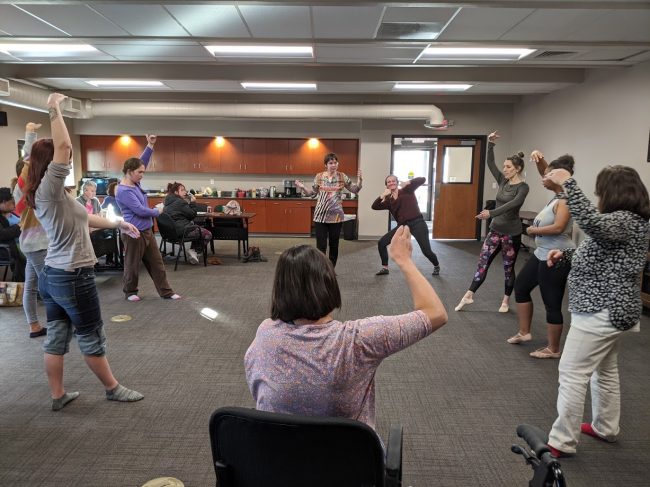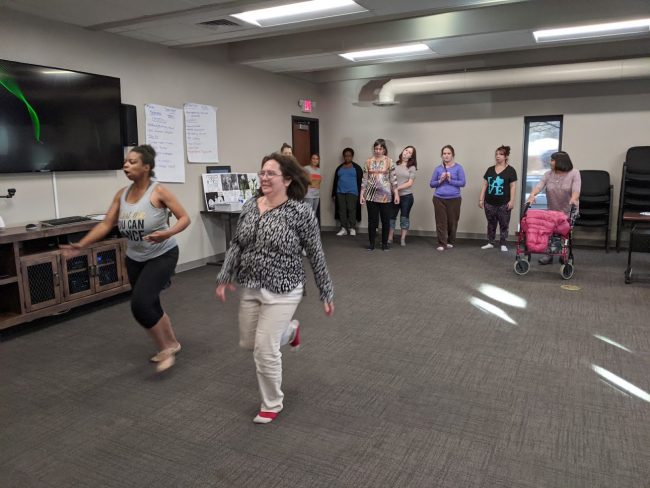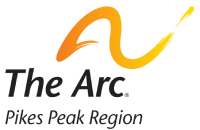By: Tonia Nifong
“Dancing is surely the most basic and relevant of all forms of expression. Nothing else can so effectively give outward form to an inner experience.” -Lyall Watson
Dance is a powerful tool not only for self-expression, but also for holistic well-being, as dance unites all aspects of an individual, mental, physical and emotional. This element of dance and movement makes it an excellent activity for people with intellectual and developmental disabilities (I/DD), to experience an enhanced quality of life.
With this in mind, Building for Change, The Arc Pikes Peak Region’s campaign to construct an inclusive, life-skills resource center for people with I/DD, will include a movement space where dance and other physical fitness-related activities will take place. Check out four ways that the joy of dance and movement make life all the richer for people with I/DD.

The Arc Pikes Peak Region’s Sisterhood of Empowered Women’s Group enjoyed an inclusive dance class in November 2019.
1. Improved emotional well-being. Emotions tied to experiences like joy or trauma are often stored in the body, impacting daily life, even if subconsciously. Dance classes for people with I/DD provide a safe space for participants to experience and express those emotions, rather than suppressing them. In her article on the advantages of dance therapy, dancer Martha Krabill says, “Dance therapy is a great way to express emotions that are sometimes not easily expressed verbally. Participants are able to express their emotions in a fun and yet therapeutic manner… Even clients with limited mobility are still able to express themselves through their own energy levels and abilities.” Dance and movement help participants to understand that what is physically happening in their bodies can be related to certain thoughts or experiences, and the movement often helps uncover this connection.
2. Social skills and connection. Because dance takes place in a class setting with others and often involves partner work, it is an excellent tool for fostering connection between the dancers. When dancers connect with each other in movement, they’re able to move past the barriers of verbal language, as movement often expresses what words cannot. The experience leaves the participant feeling understood and known on a deeper level, and that kind of connection is important for people with I/DD. Studies show that the subjective feeling of loneliness increases the risk of death by 26% — Dance is such an important tool for connecting with others!
In fact, dance is such a powerful way to connect with others that this literature review recommends dance as a way to help youth with disabilities transition from high school to adulthood. The article explains that even more than academic skills, social skills are imperative for successful integration into the community.
Dance can help develop and improve social skills, socialization, interaction, self-esteem, making friends and communication skills.
The dance literature review also suggests that dance can help non-disabled peers be inclusive of their peers with a disability, and vice versa.
In the end results showed that there was an increase in shared participation of all group members in the dance context and dancing helped shape the way participants played outside of the dance classroom, where the non-disabled peers modified their game-play because the idea of dancing in different levels or on different body parts seemed to transfer to the way children played together.
3. Dance helps create a sense of autonomy. This article on the power of dance and movement therapy for people with I/DD explains that, “Those with DD are a group of individuals that are often told what to do and when to do it, whether this relates to personal hygiene, appropriate social behavior, or how to take public transportation. My approach to dance and movement therapy is to create an environment that allows and accepts what movement activity my clients want to do for the allotted group time.” Paradoxically, moving in a group with others highlights the participant’s own individuality, as the dancer is able to control their own body while simultaneously participating in group movement.

Participants of The Arc Pikes Peak Region’s Sisterhood of Empowered Women’s Group enjoy “movement across the floor” in an inclusive dance class.
4. Dance improves health. In addition to being an excellent form of exercise, dance is a powerful form of therapy for children with disabilities because of its sensorimotor integration. Dance helps to improve balance, strength, muscle coordination, where the body is in space, sense of touch, and more. For children with sensory disorders, dance can help them to process the sensory experiences they have on a daily basis. You can read more about how dance benefits health here.
Not only are dance and movement classes a source of fun and joy, but they are a way to help people with I/DD experience greater connection to one other, express emotions, and enjoy improved health.
The Arc Pikes Peak Region’s Building for Change Inclusive Personal Development Center will feature a multipurpose room, offering people with I/DD dance, movement, fitness, and other classes.
We encourage you to give cheerfully to this project through Indy Give! until midnight on December 31, 2019, at www.indygive.com/thearc.
Subscribe To Our Newsletter and SMS Reminders
The best way to ensure that you receive our newsletter, our event invitations, SMS reminders and other important information is to become a member of The Arc of the Pikes Peak Region.
The best way to ensure that you receive our newsletter, our event invitations, and other important information is to become a member of The Arc of the Pikes Peak Region.

